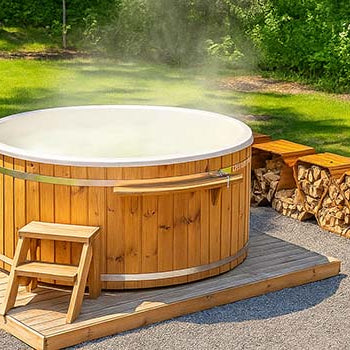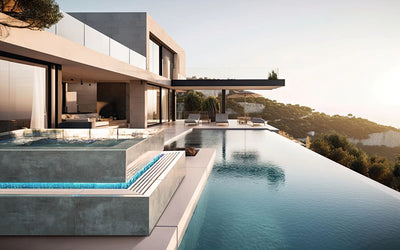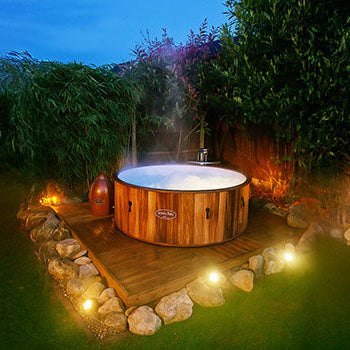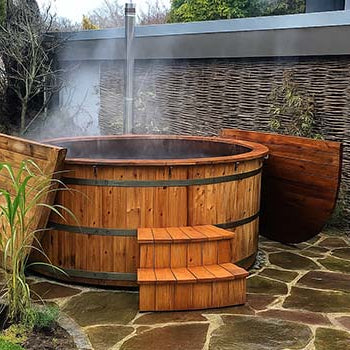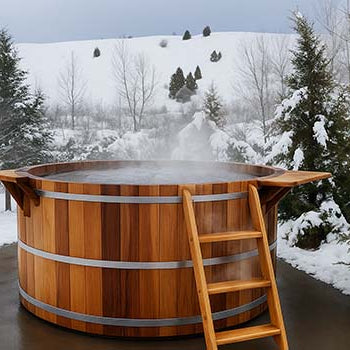Looking for the most energy-efficient hot tub in the UK? The answer: models with full-foam insulation, smart heating, and tightly sealed covers offer the best savings. Whether you're eyeing a glossy acrylic spa, a rugged rotomoulded tub, or a wooden hot tub with countryside charm, each has its energy tricks. Let’s break it down, hot, bubbly facts ahead.

What Makes a Hot Tub Energy Efficient?
You wouldn’t leave your front door open with the heating on, right? A hot tub works the same way. Energy efficiency boils down to how well it keeps the heat in, and how little power it needs to do the job. The goal? More soak, less spend.
Minimising Heat Loss Through Superior Insulation
The better the insulation, the longer your water stays warm. Full-foam insulation acts like a thermal blanket, locking heat in from every angle. Skip this and your heater ends up doing overtime, especially during chilly UK evenings.
Reducing Power Consumption of Pumps and Heaters
Pumps and heaters are hot tub workhorses, but they shouldn’t act like gym junkies 24/7. Modern energy-saving models use low-watt pumps and heaters that only switch on when necessary. Think of them as the "smart workers" of the spa world, efficient and effective.
How Efficiency Translates to Lower Running Costs
It’s simple maths: less heat loss and smarter energy use = lower bills. Energy-efficient tubs typically cost £1 to £1.50 per day to run. That’s a far cry from older models guzzling up to £3 daily. Over time, that adds up to serious savings.
Essential Features of Low-Energy Hot Tubs
If you're shopping smart, these are the non-negotiables for an energy-efficient soak.
Full-Foam Insulation: The Gold Standard Explained
Hot tub pros swear by this, and for good reason. Full-foam fills every gap between the shell and cabinet, stopping heat from escaping into the air. Acrylic Hot Tubs often come with this setup as standard, and it's worth every penny.
Multi-Density Foam and Thermal Layering Techniques
This is like having layers of cosy jumpers instead of just one thick coat. Some tubs combine foams of different densities, targeting heat retention where it matters most. Bonus points if they include reflective thermal wraps.
High R-Value, Tight-Sealing Thermal Covers
Your cover is the unsung hero of hot tub efficiency. A thick, high R-value cover with tight seals keeps heat where it belongs, inside the tub. It’s the difference between sipping wine in warm bubbles and watching your energy budget evaporate.
Energy-Efficient Circulation Pumps
Big pumps sound impressive, but they can be power-hungry. Low-watt circulation pumps quietly do their job while using a fraction of the energy. They keep the water clean and warm without draining your wallet.
Well-Designed Plumbing for Optimal Flow
Imagine a traffic jam in your pipes. Not ideal. Smart plumbing design minimises resistance, so water flows easily and your system doesn’t have to work overtime. Less pressure, less power, more efficient all around.
Smart Controls with Economy/Programmable Modes
Why heat your tub when you're at work or on holiday? Tubs with programmable timers and economy modes let you heat only when you need to. Set it, forget it, and still come home to steaming bliss.

Cutting-Edge Energy Saving Technology
This is where things get fun. Some of the newest tech takes energy savings to the next level, and it’s surprisingly clever.
Air Source Heat Pumps for Hot Tubs in the UK
These work a bit like a reverse fridge. They pull warmth from the air, even in cool climates, and transfer it to your hot tub. The result? Up to 70% less energy used compared to traditional heaters. Magic? No. Just brilliant engineering.
Waste Heat Recovery from Pumps
Ever noticed how your laptop charger gets warm? Pumps do that too. Some hot tubs reuse that ‘waste’ heat to warm the water, giving you free energy with zero extra effort. It’s like getting bonus bubbles for doing nothing.
Identifying Efficient Hot Tubs in the UK Market
Not every hot tub wears its efficiency on its sleeve. Here’s how to spot the real energy-saving stars.
Asking Specific Questions About Insulation (Type, Density)
Don’t be shy, ask the seller what kind of insulation the tub uses. Full-foam? Thermal wrap? Density ratings? The more you know, the better your long-term savings.
Checking Circulation Pump Wattage
A high-watt pump might sound powerful, but it’s also expensive to run. Aim for 50–100W pumps, they're more than capable of keeping things flowing without draining electricity.
Assessing Cover Specifications
Ask about the cover thickness. You want at least 4 inches of high-density foam and a tight seal. Heat escapes fast without it, especially during those windy UK nights.
Looking for Brand-Specific Energy-Saving Systems
Some manufacturers develop clever systems like thermal lock panels or hybrid heating. These can seriously slash running costs, just make sure it’s not all marketing fluff.
Considering Independent Test Data (e.g., TUV, WhatSpa? comparisons)
If it’s been tested, it’s been trusted. Look for third-party data or WhatSpa? reviews to get real-world energy usage stats. These give you hard numbers, not just hopeful promises.
UK Brands Recognised for Energy Efficiency
The UK hot tub market has come a long way. Many brands now focus on eco-conscious features as standard, not add-ons.
Researching Manufacturers Prioritising Low Running Costs
Some hot tub makers are proud of their efficiency, and rightly so. They’ll highlight daily running costs, insulation specs, and heat pump compatibility front and centre. If it’s buried in the small print, ask why.
Evaluating Independent Reviews and Owner Feedback
Want the truth? Read what real owners say. Search for Acrylic, Wooden, or Rotomoulded Hot Tub reviews that mention actual running costs. It’s the best way to spot consistent performance, or red flags.
Your Role in Maximising Efficiency
Even the most high-tech spa won’t work wonders without a bit of help from you. Here’s how to keep energy bills low without sacrificing comfort.
Strategic Placement and Wind Protection
Stick your hot tub in an open field and you’ll feel the chill, fast. Place it near a wall or fence for natural wind protection, or add a pergola for extra shelter.
Diligent Use of the Cover
Treat your thermal cover like a lid on a kettle. Always put it on when you’re done, even short exposure can undo hours of heating. Make it a habit.
Smart Temperature Management Strategies
Do you really need it at 40°C all the time? Lowering the temp to 37°C can still feel amazing and save a surprising chunk of energy. Bonus tip: set timers to heat during off-peak hours, if your tariff allows.

Conclusion: Prioritising Efficiency for Sustainable Soaking
If you want luxurious dips without the sky-high bills, energy efficiency should top your list. From tight insulation and smart heating tech to well-sealed covers and clever controls, today’s best hot tubs are built to save.
No matter the style, whether it's a sleek acrylic model, a tough rotomoulded spa, or a charming wooden hot tub in your garden, the key lies in the design details and how you use it. Ask questions, check reviews, and choose smart.
An efficient hot tub doesn’t just save money, it makes every soak feel like a win for your wallet and the planet.
